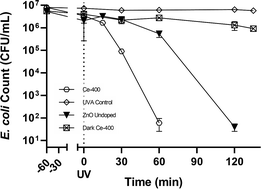Our official English website, www.x-mol.net, welcomes your
feedback! (Note: you will need to create a separate account there.)
Inactivation of an urban wastewater indigenous Escherichia coli strain by cerium doped zinc oxide photocatalysis†
RSC Advances ( IF 3.9 ) Pub Date : 2018-07-20 00:00:00 , DOI: 10.1039/c8ra05020a Ian Zammit 1 , Vincenzo Vaiano 2 , Giuseppina Iervolino 2 , Luigi Rizzo 1
RSC Advances ( IF 3.9 ) Pub Date : 2018-07-20 00:00:00 , DOI: 10.1039/c8ra05020a Ian Zammit 1 , Vincenzo Vaiano 2 , Giuseppina Iervolino 2 , Luigi Rizzo 1
Affiliation

|
Heterogeneous photocatalysis (HPC) is a subset of Advanced Oxidation Processes (AOPs) with potential future applications in water disinfection. Herein, a zinc oxide photocatalyst was doped with cerium at various atomic ratios ranging from 0 to 0.1 Ce : Zn. Keeping in mind that the application of HPC is often limited by its cost of use, a simple and easy to upscale method, that is the hydroxide induced hydrolysis of zinc nitrate in the presence of Ce3+ followed by calcination at 300 °C, was used to synthesise the catalysts. The catalysts have been characterized by different techniques such as X-ray diffraction (XRD), UV-vis diffuse reflectance (UV-vis DRS) and Raman spectroscopy. XRD results showed that Ce3+ ions were successfully incorporated into the ZnO lattice. UV-vis DRS spectra evidenced that Ce–ZnO samples present band-gap values of about 2.97 eV, lower than those of undoped ZnO (3.21 eV). These various photocatalysts, at 0.1 g L−1 in saline 0.85%, were used to inactivate Escherichia coli previously isolated from an urban wastewater treatment plant. Higher atomic ratios of Ce in the ZnO lattice, as confirmed by XRD and Raman spectroscopy, showed significant improvements to the inactivation rate; the resulting recommended optimum cerium loading of 0.04 : 1 Ce : Zn gave multiple orders of magnitude higher rate of inactivation after 60 min of treatment when compared to un-doped ZnO. This optimum loading of cerium was faster than the de facto literature standard TiO2-P25 tested under identical conditions.
中文翻译:

铈掺杂氧化锌光催化灭活城市废水原生大肠杆菌菌株†
多相光催化 (HPC) 是高级氧化过程 (AOP) 的一个子集,在水消毒中具有潜在的未来应用。在此,氧化锌光催化剂以0至0.1 Ce:Zn的各种原子比掺杂铈。请记住,HPC 的应用通常受到其使用成本的限制,这是一种简单且易于升级的方法,即在 Ce 3+存在下氢氧化物诱导硝酸锌水解,然后在 300 °C 下煅烧,是用于合成催化剂。催化剂已通过不同的技术进行表征,例如 X 射线衍射 (XRD)、紫外可见漫反射 (UV-vis DRS) 和拉曼光谱。XRD结果表明Ce 3+离子成功地结合到 ZnO 晶格中。UV-vis DRS 光谱表明 Ce-ZnO 样品的带隙值约为 2.97 eV,低于未掺杂的 ZnO (3.21 eV)。这些各种光催化剂(在 0.85% 盐水中的浓度为 0.1 g L -1)用于灭活先前从城市污水处理厂分离的大肠杆菌。XRD 和拉曼光谱证实,ZnO 晶格中较高的 Ce 原子比表明失活率显着提高;与未掺杂的 ZnO 相比,最终推荐的 0.04 : 1 Ce: Zn 的最佳铈负载量在处理 60 分钟后产生了多个数量级的失活率。铈的这种最佳负载比事实上的文献标准 TiO 2更快-P25 在相同条件下测试。
更新日期:2018-07-20
中文翻译:

铈掺杂氧化锌光催化灭活城市废水原生大肠杆菌菌株†
多相光催化 (HPC) 是高级氧化过程 (AOP) 的一个子集,在水消毒中具有潜在的未来应用。在此,氧化锌光催化剂以0至0.1 Ce:Zn的各种原子比掺杂铈。请记住,HPC 的应用通常受到其使用成本的限制,这是一种简单且易于升级的方法,即在 Ce 3+存在下氢氧化物诱导硝酸锌水解,然后在 300 °C 下煅烧,是用于合成催化剂。催化剂已通过不同的技术进行表征,例如 X 射线衍射 (XRD)、紫外可见漫反射 (UV-vis DRS) 和拉曼光谱。XRD结果表明Ce 3+离子成功地结合到 ZnO 晶格中。UV-vis DRS 光谱表明 Ce-ZnO 样品的带隙值约为 2.97 eV,低于未掺杂的 ZnO (3.21 eV)。这些各种光催化剂(在 0.85% 盐水中的浓度为 0.1 g L -1)用于灭活先前从城市污水处理厂分离的大肠杆菌。XRD 和拉曼光谱证实,ZnO 晶格中较高的 Ce 原子比表明失活率显着提高;与未掺杂的 ZnO 相比,最终推荐的 0.04 : 1 Ce: Zn 的最佳铈负载量在处理 60 分钟后产生了多个数量级的失活率。铈的这种最佳负载比事实上的文献标准 TiO 2更快-P25 在相同条件下测试。











































 京公网安备 11010802027423号
京公网安备 11010802027423号